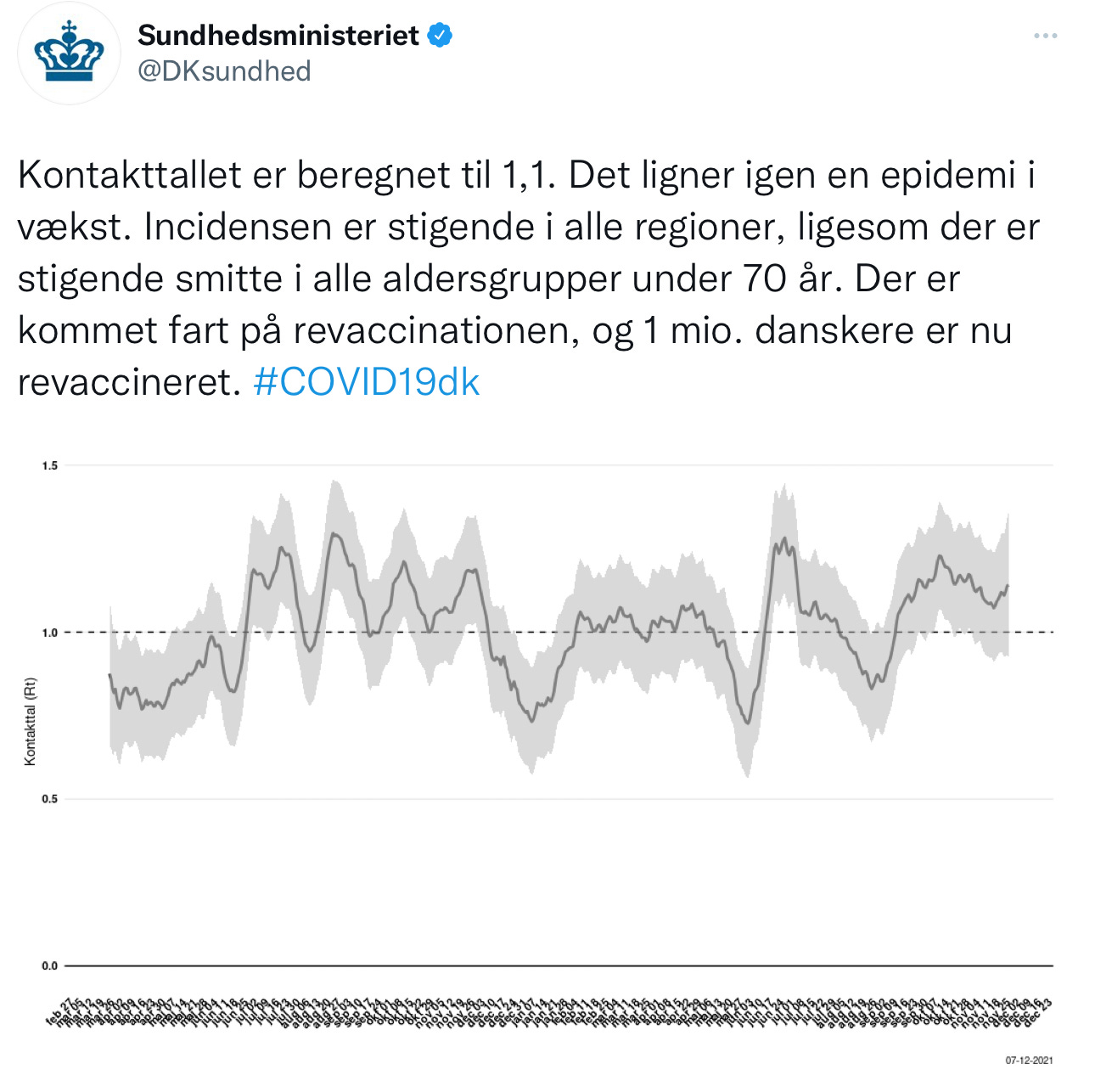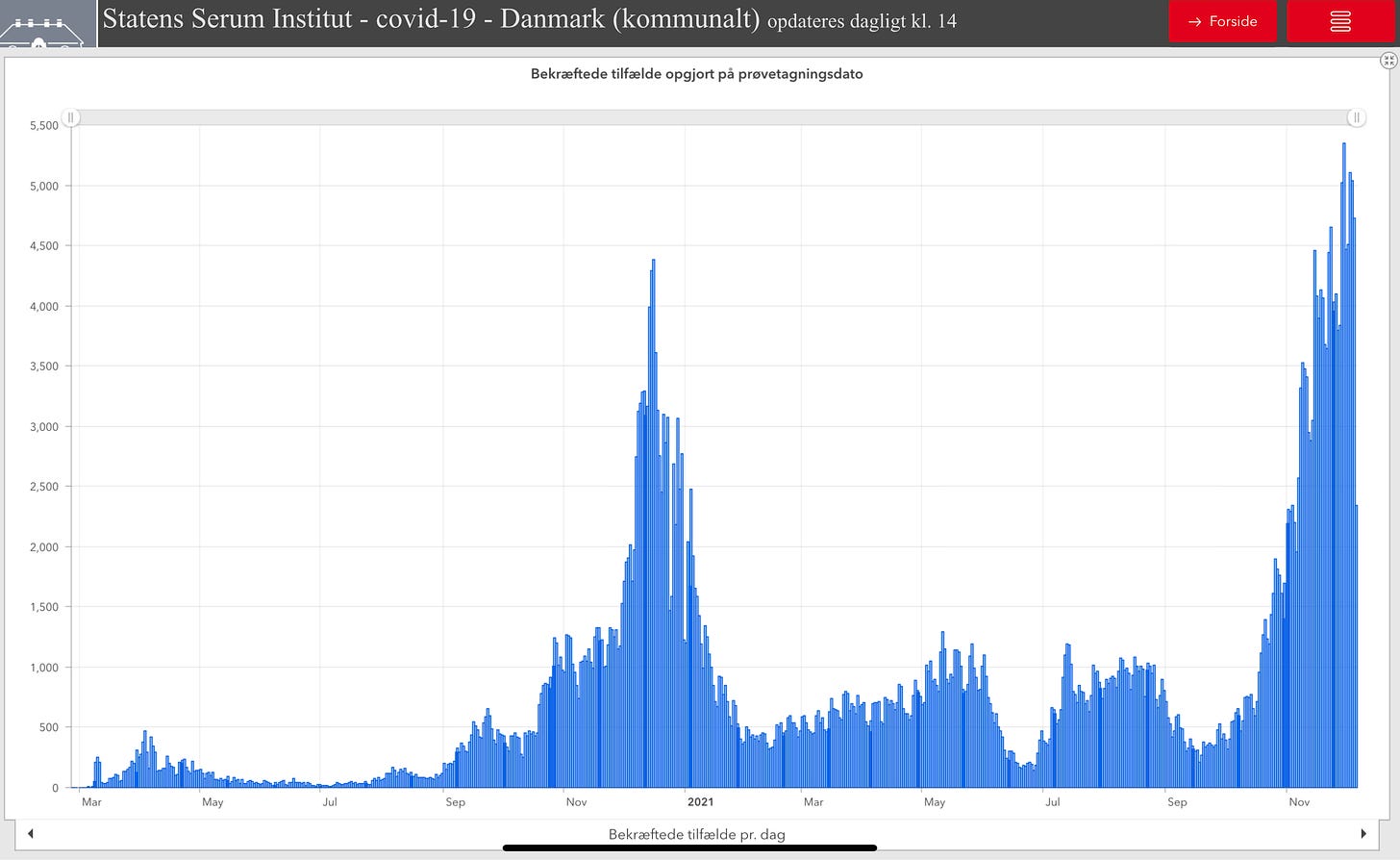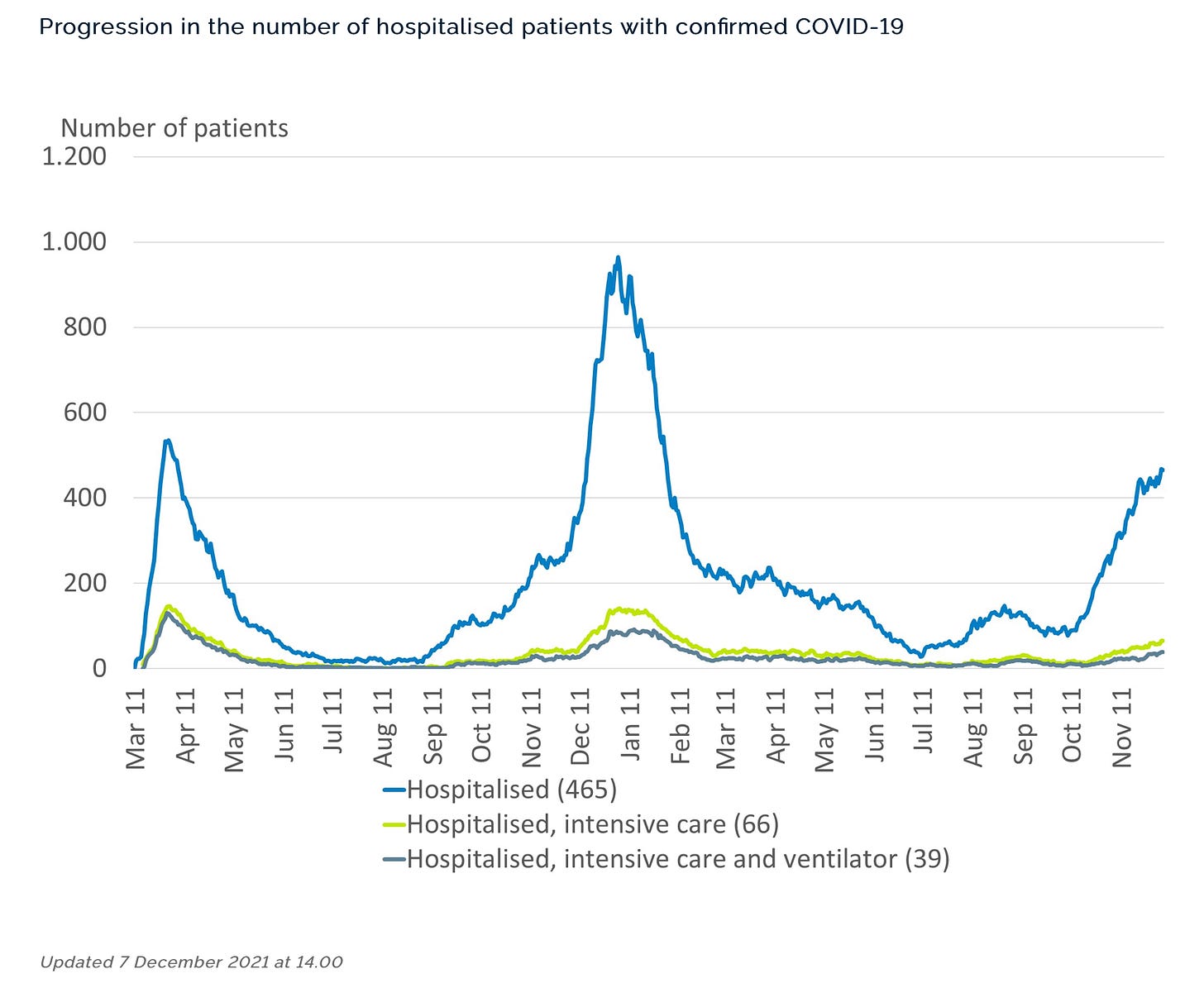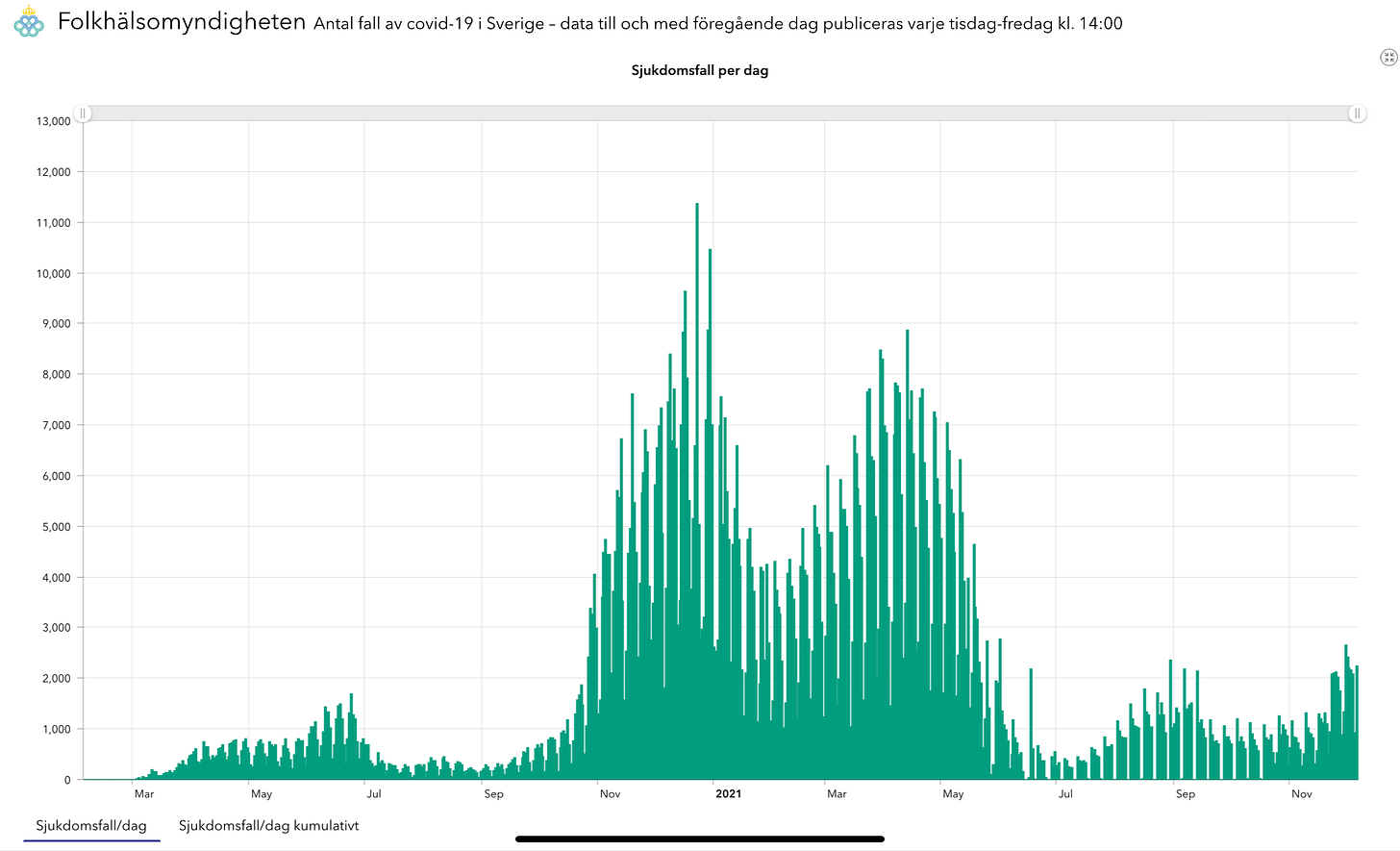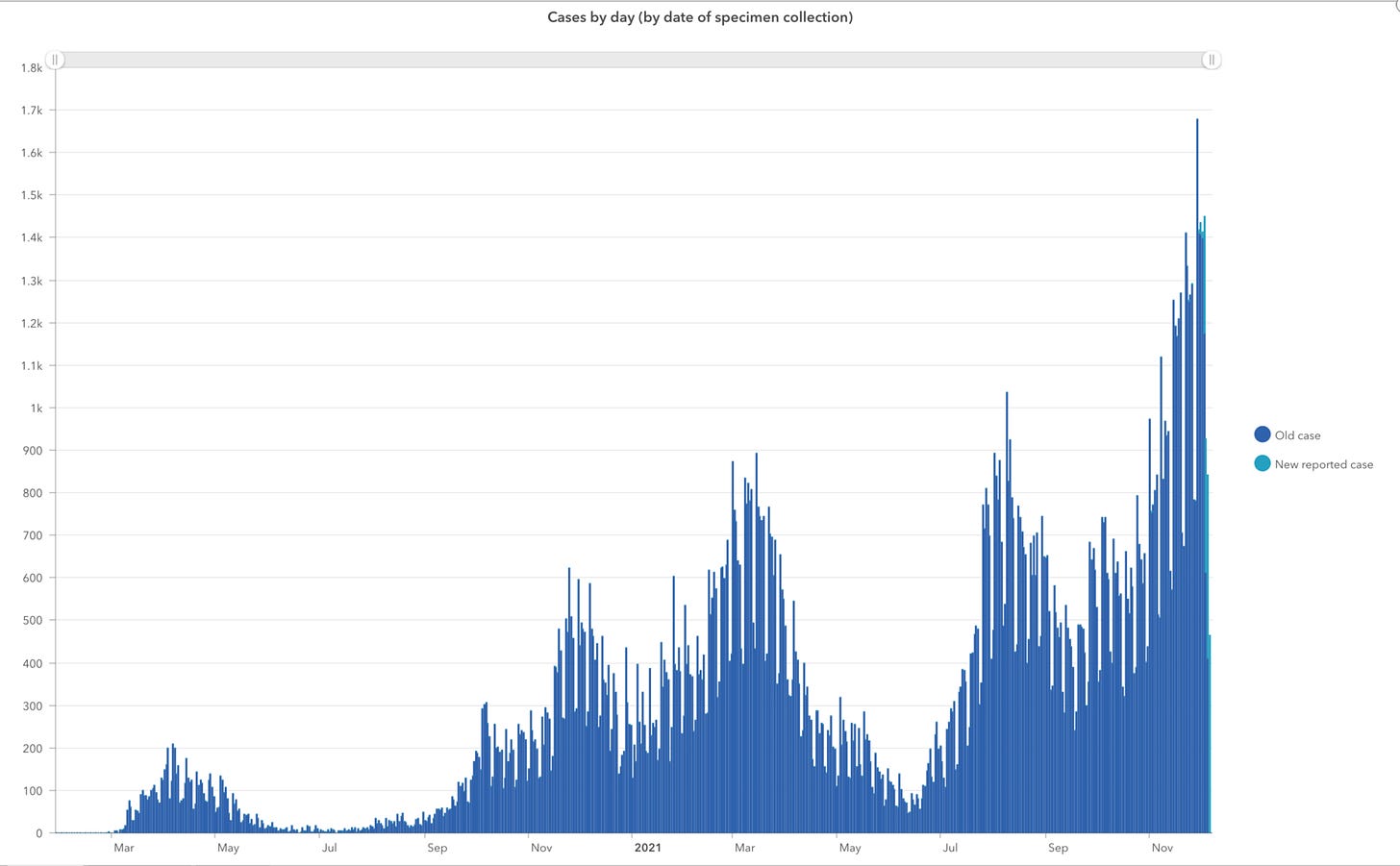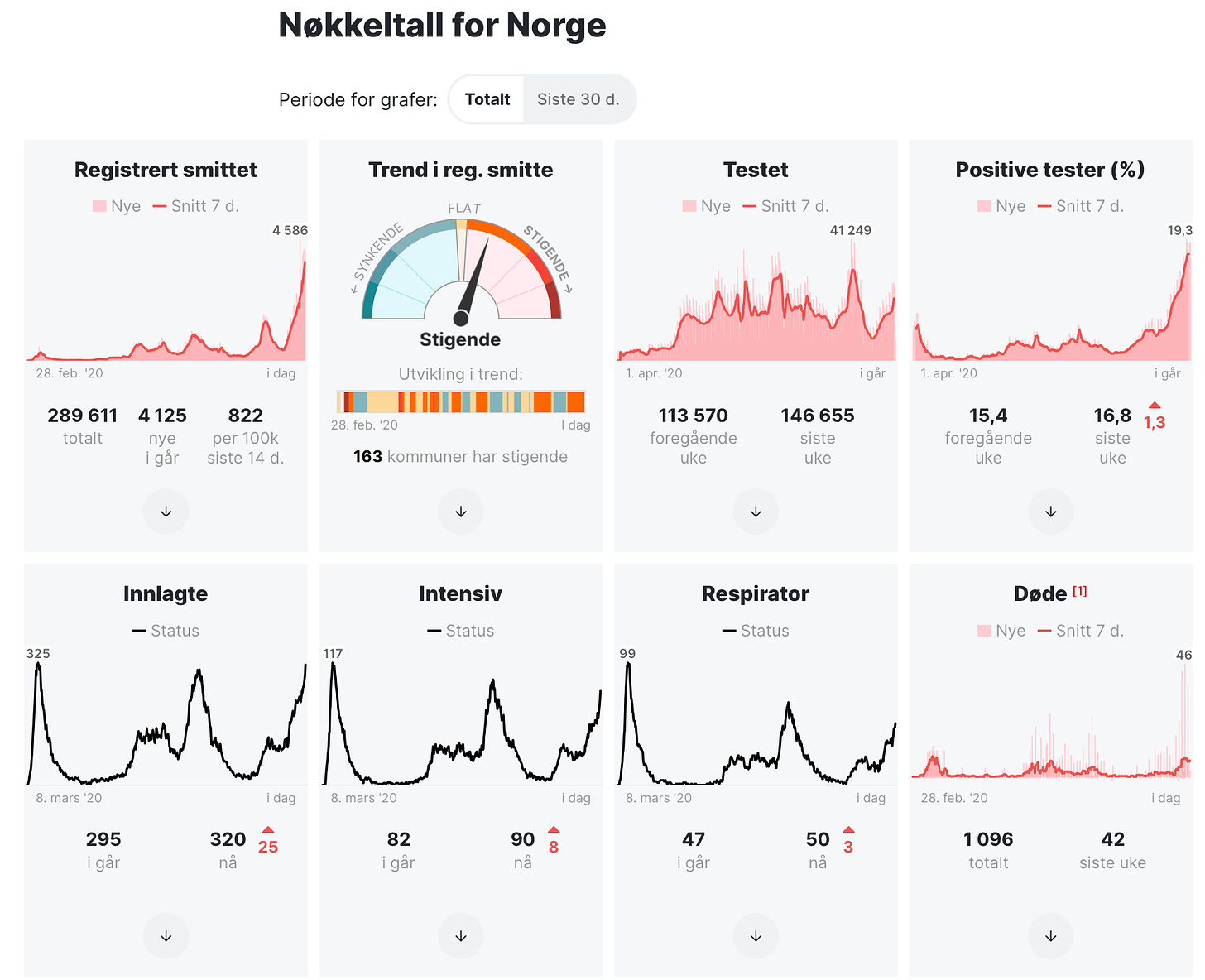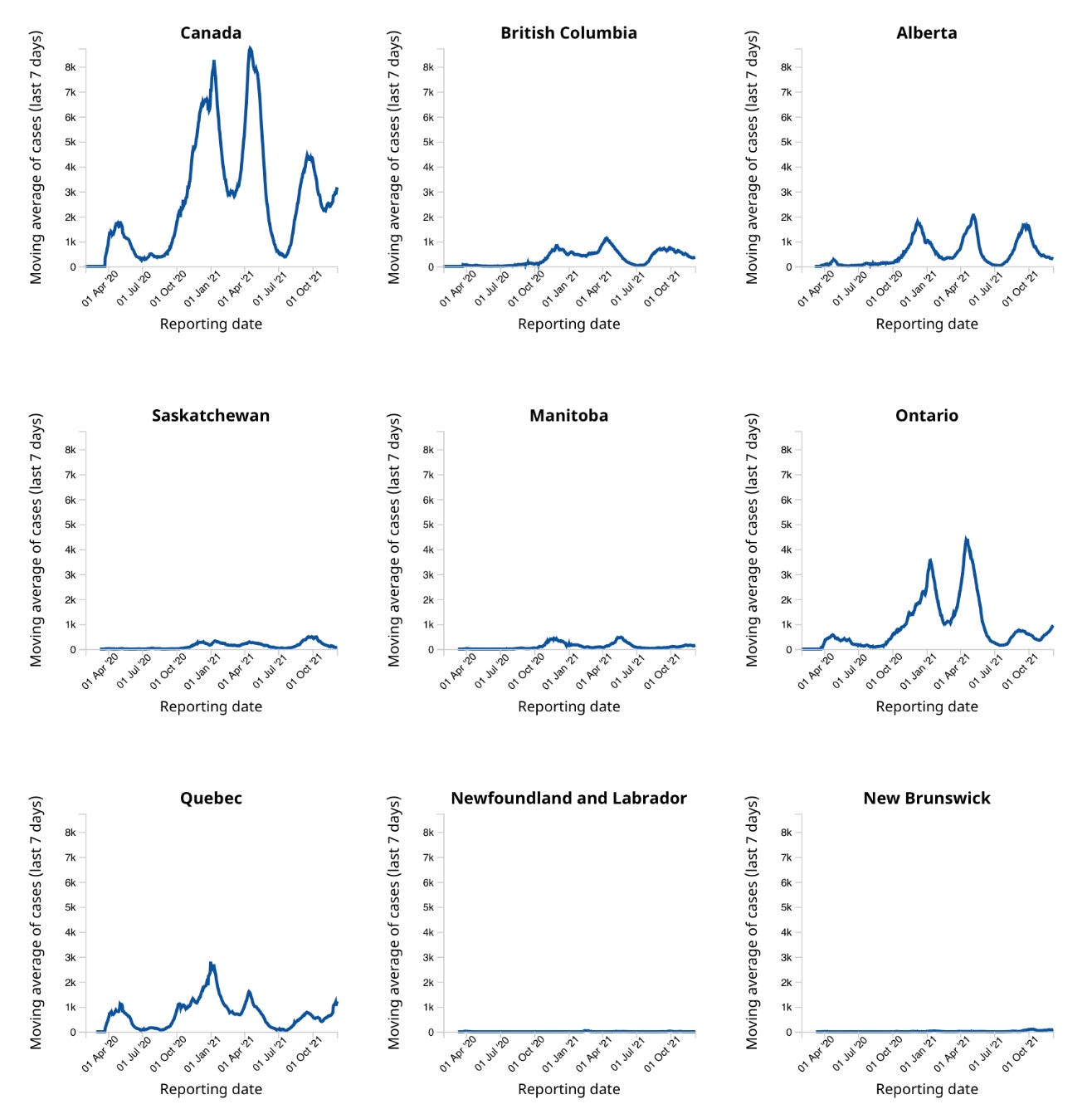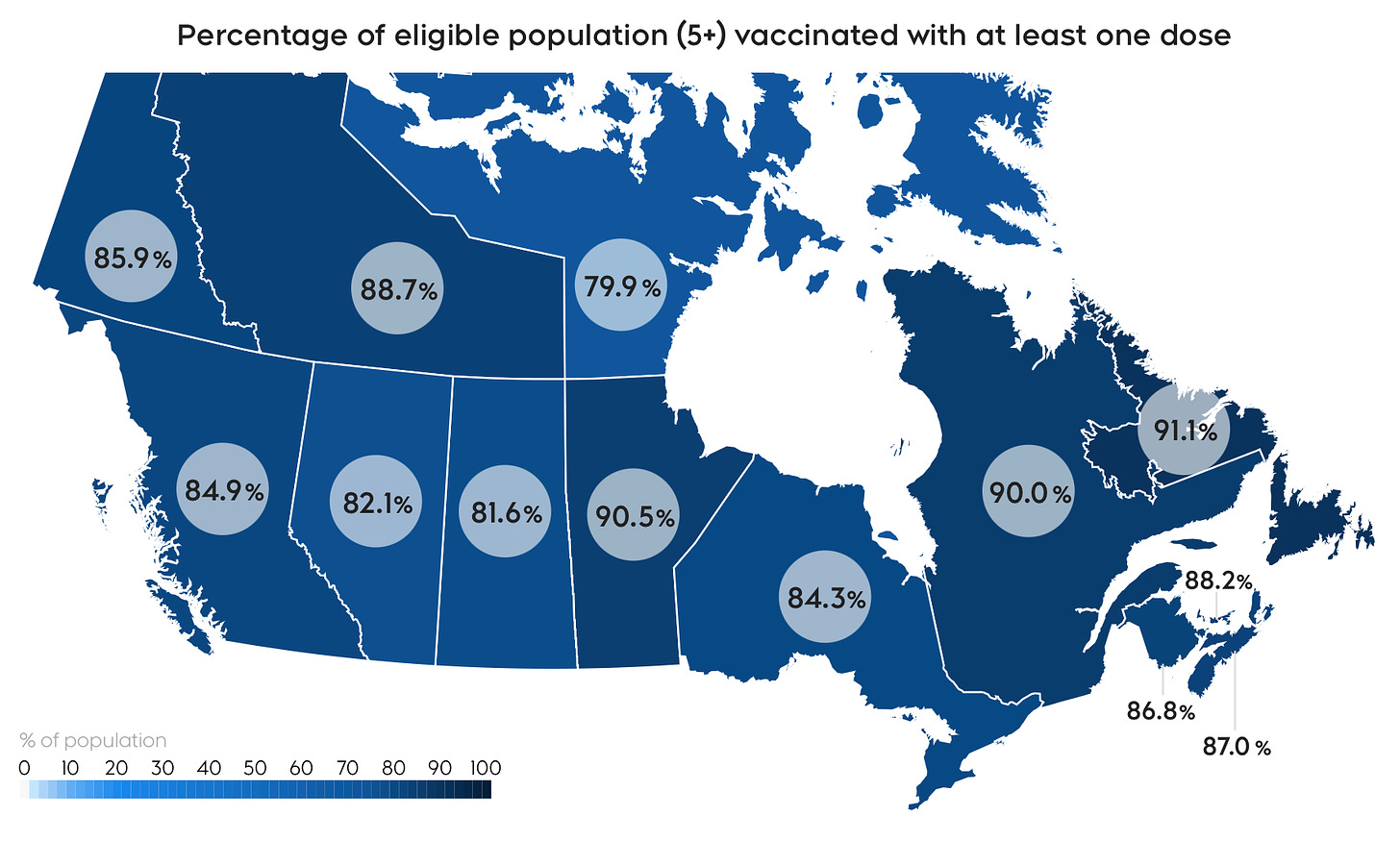The Evening Report - Dec 7
🇩🇰
Danish health agencies updated the COVID situation at a press conference today. Staten Serum Institut Director Henrik Ullum said the number of confirmed Omicron infections has increased to 398 as of today, up from a reported 18 just last Friday, and an increase of 137 from Monday to Tuesday. He also confirmed the first Omicron related hospitalization. Ullum says community transmission of the variant is now significant.
“Where the infection previously came from travelers coming into Denmark, more than 90% are now infected within Denmark. Everything indicates that Omicron is highly contagious, and everything indicates that it is seeing strong growth across Denmark.”
If there is any hopeful news, Ullum says all the data so far, no there isn’t a lot of it, indicates that current vaccines offer strong protection against serious illness, hospitalization, and death.
Community spread of the Omicron variant has now overwhelmed measures put in place just days ago to contain its spread. At the end of November the Danish Health and Medicines Authority mandated testing and isolation for three degrees of close contacts from an infected person. That recommendation has now been rescinded.
Omicron variant fears and overall soaring infections rates are leading to a major run on contact tracing and information lines at the Danish Agency for Patient Safety. Director Anette Lykke Petri says just yesterday people manning the agencies phone lines received 43,000 calls while also contacting 8,000 people to do contact tracing.
Petri says many of those could have been avoided if people would have just gotten quick test right away. She says the current pressure is unsustainable and could overwhelm her agencies capabilities and put major pressure on Denmark’s PCR testing capacity.
Record high daily infections and a mounting number of Omicron outbreaks is beginning to put serious pressure on Denmark’s vaunted testing system. The Director of Denmark’s Agency for Security of Supply, Lisbet Zilmer-Johns, is asking people to only get a PCR test when it is absolutely necessary.
“Only take a PCR test if you have symptoms, or are in close contact, or have tested positive via a quick test.”
She says if you have scheduled a PCR test and no longer need to make sure to cancel it so someone else can grab it.
The Danish Agency for Patient Safety says there are currently COVID outbreaks in 312 schools along with several hospitals around the country.
The Danish National Health Board is warning of fatigue across the entire healthcare sector. Director Søren Brostrøm says the system has been under pressure for two years and is now struggling with staffing shortages, major backlogs in delayed or postponed procedures, and patients with other respiratory infections.
Brostrøm says COVID vaccines continue to be the absolute best weapon in the toolbox to combat coronavirus infections. That said, he added that restrictions may need to be tightened. Brostrøm says current restrictions are not enough to keep the epidemic at bay. He says the health board has recommended that nightlife and alcohol sales be curbed but emphasizes this is a political decision that needs to be made in the Danish parliament. To that end, Brostrøm said there may be another COVID press conference with Prime Minister Mette Frederiksen tomorrow.
-
A week ago Denmark’s COVID contact number (reinfection rate or R0) declined slightly to 1.0 with Health Minister Magnus Heunicke saying at the time that this indicated a slowing epidemic. What a difference a week makes. Since then daily coronavirus infections have shot up to record highs and the Omicron variant is spreading fast. Today Denmark’s R0 rose back up to 1.1 with the health ministry noting “it again looks like a growing epidemic” as infections are “increasing in all regions” and across every age group under 70.
-
Denmark’s Health Minister Magnus Heunicke has tested positive for COVID. Heunicke is isolating in a hotel room in Brussels, Belgium, where he was to attend an EU council meeting. The minister’s required pre-meeting rapid test came back positive and that was then confirmed by a PCR test.
In a Facebook post, Heunicke confirms the news and said the most important thing for him now is not to be a part of chains of infection impacting others. The health ministry says contact tracing efforts are underway, but the minister covered a lot of ground since Friday. He was on Copenhagen public transit and also attended a ministry Christmas party before hopping a flight to Brussels.
Heunicke says he does not know how he became infected and so far has mild symptoms mainly a sore throat. He says for the immediate future he will be resting in bed in his hotel room. Huenicke adds he is looking forward to recovering to the point where he can travel back to Denmark and see his family again.
-
An Omicron outbreak at a julefrokost in Viborg with 150 in attendance on November 27 has resulted in several other outbreaks in Jutland. The Danish Agency for Patient Safety says they have linked outbreaks at Viborg Cathedral School, Midtbyens Gymnasium, and Viborg Gymnasium to the Christmas party.
Agency Director Anette Lykke Petri:
“We can state that the infection can be traced back to the same source, and thus there is a link between the infection at the Christmas party, the Martin Jensen concert in Aalborg, and outbreaks at the three schools. And we can see that it has spread very quickly.”
So far, 69 of the 150 attendees at the Viborg Christmas party have tested positive for the Omicron variant.
-
According to a report from media outlet Nordjyske, there has been a major COVID outbreak at a school in Hjørring Kommune in North Jutland. It says 130 of the schools, 620 students have tested positive for COVID so far. The Danish Agency for Patient Safety has ordered all students in grades 0 through 5 to go home until at least December 13.
School District Leader Mads Albertsen told Nordjyske that he is puzzled as to why so many kids have become infected.
“We have worked according to the guidelines that are there to prevent infection.”
-
About 11,000 people who attended a concert at Copenhagen’s Royal Arena on Thursday last week are being urged to go get tested as soon as possible. The Danish Agency for Patient Safety says it has confirmed nine COVID infections among those who went to see the band Jung. It says so far none have been the Omicron variant.
Concert vendors United Stage and Ticketmaster have emailed everyone who bought tickets asking them to get tested.
-
Denmark is reporting 6,324 COVID infections and nine more coronavirus deaths in the last day.
Yesterday there were 413,179 corona tests done, of which 186,244 were PCR tests equaling a positivity percentage of an extremely high 3.39%.
-
COVID hospitalizations (465) declined slightly (-3) while the number of infected people in an ICU (66) crept upward (+1) and of those the number on a ventilator (39) is unchanged day to day.
-
On the vaccination front, 7,027 people had their 1st vaccine dose yesterday while the lion’s share of inoculations on Monday were booster doses, with 33,849.
So far, 78.3% of the total population have had one vaccine dose. 76.1% have had two, and the number of people who had a booster dose (16.6%) has now breached the one-million mark. .
-
Beginning Wednesday Region Midtjylland is expanding its testing infrastructure. The region will open a rapid test site in Bjerringbro. Then on Thursday and Friday two more quick test sites will open in Stoholm and Møldrup. The region is also increasing testing capacity in Viborg due to the Omicron variant outbreak there, putting added pressure on the city’s testing systems.
The new rapid testing sites will be operational for the next 14 days at least.
🇸🇪
Sweden has added 7,412 infections and seven more corona deaths since its last update on Friday.
To date, 7,632,138 1st vaccine doses (84.5% of the population aged 12 years old and older) and 7,212,687 2nd doses (79.8%) have been administered.
1,447,930 booster doses have been given so far (17.4% of the population aged 18 years old and older).
-
As of Wednesday, new measures and recommendations will come into force in Sweden to try to limit COVID infections. The Swedish Public Health Agency is hoping it buys more time to get more people vaccinated.
CEO Karin Tegmark Wisell:
“In addition to slowing the spread of infection, the new recommendations give the regions more time to reach all groups with offers of vaccines.”
As of Wednesday:
People are to keep socially distant in all public places, especially if they are indoors.
Try to use public transit at off peak times or walk, cycle, or drive to where you need to be to reduce crowding on trains and buses.
If taking a crowded bus or train cannot be avoided wear a mask.
Employers should allow flexibility for their workers to get vaccinated and to stay home if they are sick.
All workplaces should ensure employees can maintain social distancing on the job.
Employers should allow people to work from home where ever possible.
Restaurants must avoid congestion, and be set up so diners can be socially distant.
All Christmas season gatherings and activities should include measures to reduce the risk of infection.
The agency also advises unvaccinated people to stay away from all others, especially seniors and people who are at high-risk.
“Vaccination provides very good protection against COVID-related serious illness and death and to some extent against the spread of infection itself. We are still in the middle of a pandemic and it is therefore important to take extra care and caution. If all adults are vaccinated and everyone is healthy, there is no reason to advise against celebrating Christmas with relatives and friends. But be prepared to adjust quickly if you have symptoms of COVID.”
-
Region Stockholm says it is seeing an increasing number of COVID hospitalizations week to week, while infections have also increased albeit just slightly. However, the region also cautions that testing issues could mean the “actual number of infections may be higher.” It also confirms five more cases of the Omicron variant have been confirmed in the last week.
In the last seven days, there were 3,398 confirmed coronavirus infections compared to 3,272 from the week before. Of the now 120 COVID patients in hospitals 16 are in intensive care. The region also continues to warn there is a backlog in processing COVID deaths.
Chief Physician Johann Bratt:
“The healthcare situation is currently very strained with a high influx of patients. After floating between 70 and 90 COVID patients in our hospitals, we now see 30 more patients in the last seven days than we did in the week before. This is not unexpected as we have seen a steady infection increase in recent weeks. The more people who become infected, the more people that need hospital care. That is why it is very important that everyone takes responsibility. Mainly by getting vaccinated. It is still the best protection for people and for those around them.”
Bratt is urging everyone who is sick, even if they test negative, to stay home until they have had no symptoms for at least 24 hours. He is noting an increase in influenza and other seasonal respiratory ailments.
Sweden tests at a far lower capacity than Denmark making their numbers a little murkier. For example, last week Sweden’s capital region only administered 58,000 tests for the entire week.
-
Swedish newspaper Expressen is reporting COVID testing chaos in Stockholm. The newspaper reports for a second week in a row there have been major kinks in getting at home COVID tests delivered and demand on testing offered at pharmacies has led to major backlogs. This while Swedish health officials worry that the Omicron variant is spreading.
People in Stockholm can use an app to order a COVID test to be delivered to them at home but according to the newspaper for the last two weeks efforts to do so have resulted in a message saying it is not possible. Apparently Taxi Stockholm was contracted to deliver the home tests but they don’t have the time.
Taxi Stockholm Press Officer Natalia Santos told the paper:
“The demand for tests went up by over 300% the night between November 22 and 23. We try to streamline as much as we can to keep up.”
The other option is to go to a state run pharmacy to get a home test, but even there problems persist.
Region Stockholm Chief Physician Elda Sparrelid:
“We have guaranteed medical staff and travelers from abroad tests. Since then, we have increased capacity significantly until last week and this week. But we have had problems with, above all, the home tests.”
For its part, Region Stockholm tabled changes to its home-testing systems. The region is expanding the number of pharmacies where home testing kits can be picked up from 17 to 33. It will also experiment with automated boxes dispensing home testing kits in certain locations.
🇫🇮
Finland has registered 1,542 infections and one more virus death in the last 24 hours.
COVID hospitalizations (277) are unchanged.
So far, 76.6% of the total population have had one dose, 72.4% have had two, and 6.6% have had a booster shot.
-
The Finnish Institute for Health says it has now confirmed two more Omicron variant infections in the country today. This brings the total number of confirmed Omicron infections in Finland to nine so far. Both the two latest cases were people who had recently returned from South Africa and Nigeria.
Agency Leading Expert Jari Jalava:
“We are closely monitoring the international situation together with the authorities of different countries. The virus variant is already widespread, and new infections can be found in any country. However, no wider intra-country spread has yet been reported in Europe. However, the situation can change quickly.”
-
According to a report from YLE, the Finnish government is considering making COVID vaccinations mandatory for healthcare workers. There have been suspected cases of unvaccinated nurses possibly passing a coronavirus infection on to patients. One family is even claiming such an incident cost the life of their 93 year old grandmother.
The number of unvaccinated healthcare workers is a bit of a guessing game. Helsinki GSE, a cross-university research group, estimates more than 10% of healthcare workers have refused to be vaccinated. But other studies have pegged that figure to be around the 5% mark.
In Finland, employers cannot legally demand that workers show their vaccination information.
Legislation mandating healthcare workers be vaccinated could be tabled in Finnish parliament by next week.
🇳🇴
Norway has added 2,488 infections and had no new pandemic deaths in the last day.
COVID hospitalizations (320) have shot upward (+25) while the number of infected people in an ICU (90) also rose (+8) and of those the number on a ventilator (50) crept upwards as well (+3).
To date, 78.8% of Norwegians aged 12 years old and older have had one vaccine dose, 71.6% have had two, and 14.2% have had three.
-
Norway tightened existing COVID restrictions and added more into the mix today in a bid to wrestle down its infection curve.
Prime Minister Jonas Gahr Støre:
“We would very much like to be done with the pandemic. However, the situation is so serious that we must take new measures to maintain control. Therefore, it will be a different Christmas holiday this year as well. The danger of an overloaded health service and the spread of the more contagious Omicron variant necessitate new, strict measures to reduce social contact in society. To those of you who have not been vaccinated: Do so. To those of you who are offered a booster dose: Accept it.”
With more than 300 COVID patients in hospitals health officials stressed these measures are also to try and avoid having another coronavirus wave overwhelm the healthcare system. Especially with other patients coming in due to seasonal respiratory infections.
As of midnight on Thursday:
One meter social distancing rule. Family and household members are exempt. Children in kindergartens and primary schools are also exempt.
Guests in a home are capped at 10 in addition to people in your household.
The guests cap is increased to 20 during the Christmas and New Year holidays.
People should reduce their social contacts and meet outside whenever possible.
Leisure Activities:
Changing rooms must be closed and leisure activities moved outside as much as possible.
Leisure activities are capped at groups of 20 for adults 20 years old and older with a one meter social distancing rule, which increases to two meters for high-intensity training.
Schools
Schools in high infection areas to undergo regular testing.
If necessary school districts can reimplement the traffic light model with free, yellow, and red COVID risk assessments mandating different measures.
University, college, and vocational schools should “as soon as possible” reduce class sizes and move as many students online as possible. S
All of the above colleges and universities should implement infection control measures as a matter of course.
Workplaces
Employees should one-meter social distancing space at work. Those that can work from home should.
If social distancing is not possible in the workplace, then there should be plastic shields between workers or they should be masked.
For libraries, amusement parks, swimming pools, water parks, spa facilities, hotel pools, gyms, bingo halls, gaming halls, shopping centers, shops, trade fairs, temporary markets and the like, they must abide by some basic infection control measures. These include one meter social distancing, proper ventilation, and access to hand sanitizer and facilities where hands can be washed.
With the exception of libraries, shops and shopping centers, companies must register contact information for those guests who agree to it.
Ventilation
Indoor spaces where people have to spend time in a group with others that they do not live with should be properly ventilated.
Events and Gatherings
All private gatherings in a borrowed or rented public space are capped at 20.
Memorials and funerals are capped at 50.
Any event with fixed public seating is capped at 600 with attendees in three cohorts of no more than 200. There needs to be two meters of social distancing between cohorts. Within cohorts each household should have one empty seat between them.
For public events without fixed seating attendance is capped at 50.
All alcohols sales are to stop at midnight.
Bars and Restaurants
All alcohol sales are to cease at midnight.
Alcohol can only be served directly to the table.
Restaurants are to ensure one meter social distancing between groups of diners.
Restaurants with a liquor license must make sure every guest is seated.
Restaurants must gather contact tracing information from all guests.
Masks
Face masks are mandated in any space where a one meter social distancing cannot be maintained.
Hairdressers, dermatologists, and other one-on-one professions are required to wear masks, as are their customers.
Quarantine
Norwegian health authorities are extending an isolation requirement in relation to any Omicron variant infection to close contacts of the infected person and their close contacts. So anyone two-degrees removed from an infected person must isolate pending negative test results.
-
The latest COVID threat assessment from the Norwegian Institute of Public Health describes the situation as serious. The agency notes infections are “increasing rapidly” and that is being followed by increasing numbers of hospital admissions. The NIPH says the healthcare situations is being complicated by rising numbers of staff out sick and a lack of access to temporary workers.
It says this is a situation that could be even further exacerbated by the Omicron variant, which the health agency is forecasting will be the dominant COVID strain in Norway by January “at the latest.” Norway has already recorded a number of Omicron cases, including a large outbreak at a Christmas party held in a restaurant in Oslo.
Norway’s national health agency is warning that the Omicron variant could trigger a rapid escalation in COVID cases, causing “a wave with a significant disease burden” unless “measures are taken to limit this.”
Crisis Manager and Department Director Line Vold:
“We expect that the number of Omicron infections will increase rapidly in the coming weeks. This, together with the already increased burden on the health service, means that we now consider the situation to be very serious.”
The NIPH recommends everyone get vaccinated and a booster dose if eligible, saying that all available evidence indicates vaccines protect against serious illness and death, even from the new variant.
The NIPH is also worried about the potential for a strong seasonal influenza outbreak in December and January but is hoping increasing COVID restrictions will head it off.
-
Norway is reducing the gap between a 2nd vaccine dose and a booster shot from six to five months for everyone who is currently eligible for a 3rd dose.
Norwegian Public Institute of Health Assistant Director Geir Bukholm:
“In a situation with increased infection pressure in society and thus an increased risk of serious illness among some groups, it now opens up for a shorter interval for a booster dose. It will provide greater flexibility when carrying out vaccinations in municipalities.”
Currently in Norway, booster doses have been offered to nursing home residents, everyone 45 years old and older, people 18 to 44 years old who have underlying medical conditions putting them at risk, and all healthcare workers.
🇫🇷
As COVID cases mount in France, the country’s Prime Minister has ordered all dance clubs, discos, and nightclubs to close. The closure will come into force this weekend and will last for at least four weeks.
🇦🇹
Austria will come out of its national COVID lockdown next week as planned, or at least the vaccinated members of the population will. The country went into a national lockdown two weeks, a week after putting its unvaccinated population in their own lockdown. While restrictions lift next week for those with two doses people who have refused to get vaccinated will remain in their own homes, only allowed to leave for necessary tasks like work or going to get groceries.
🌍🦠
Last month, the World Health Organization’s European Regional Office warned that a further 500,000 lives could be lost in the region by early 2022 if urgent action was not taken. Today, it was reported that things are indeed heading in that direction. The WHO includes 53 countries in its European region, including the EU and Russia, but also as far-flung as Turkey and everything in between.
WHO Regional Director Hans Kluge said there have been another 120,000 deaths in the region and 10 million more COVID cases have been added to the region”s tally in just the last month. With the holiday season fast approaching, daily pandemic deaths have record 4,100 lives lost. That is double the mortality rate seen in September.
“As school holidays approach, we must also acknowledge that children contaminate their parents and grandparents at home, with a ten times increased risk for these adults to develop severe disease, be hospitalized, or die when non-vaccinated. The use of masks, ventilation, and regular testing, should be a standard at all primary schools and vaccinating children should be discussed and considered nationally, as part of school protection measures.”
However, the agency also notes that vaccinations since the first doses began to be administered last September until now have saved an estimated 470,000 lives.
Kluge notes people should be concerned about the Omicron variant.
“Omicron is in sight and on the rise, and we are right to be concerned and cautious.”
But he added that the Delta variant is the current problem.
“If we succeed against Delta today, [that] is a win over Omicron tomorrow."
🇨🇦
Canada reported 2,876 COVID infections and suffered another 27 coronavirus deaths yesterday.
On the vaccination front, 31,084,779 1st vaccine doses (81.3% of the total population) have been administered while 29,113,919 people (76.14%) are now fully vaccinated. 1,887,247 fully vaccinated people have also received a booster dose.
Without factoring in the Omicron variant, new COVID modeling in Ontario suggests the province could see around 3,000 coronavirus infections per day along with increased hospitalizations by the end of January. The modeling calls for vaccinations to be stepped up, especially among five to 11 years olds, and for more public health measures.
In Ontario today there were 928 new COVID cases and nine more deaths. There are 340 people in hospital, of which 256 are not fully vaccinated or not vaccinated at all. Of the 165 people in an ICU, that number is 146.
Quebec reported 1,234 new infections and five more pandemic deaths on Wednesday.
In Atlantic Canada, New Brunswick had 69 new COVID cases.
Manitoba saw 93 new corona cases and four more deaths as the province recorded its first Omicron variant infection.
There were 47 infections in Saskatchewan on Tuesday.
Alberta logged 788 infections and five more deaths over a three day period covering Saturday through Monday. There are 294 people in hospital, of which 64.3% have either one dose or none at all. Of the additional 72 in an ICU, that number is 76.4%.
B.C. registered 946 infections and another 11 deaths over a three day period covering the weekend. There are 241 people in hospital, of which 89 are in intensive care. 80% of those in an ICU are not fully vaccinated. The province is confirming five cases now of the Omicron variant.




